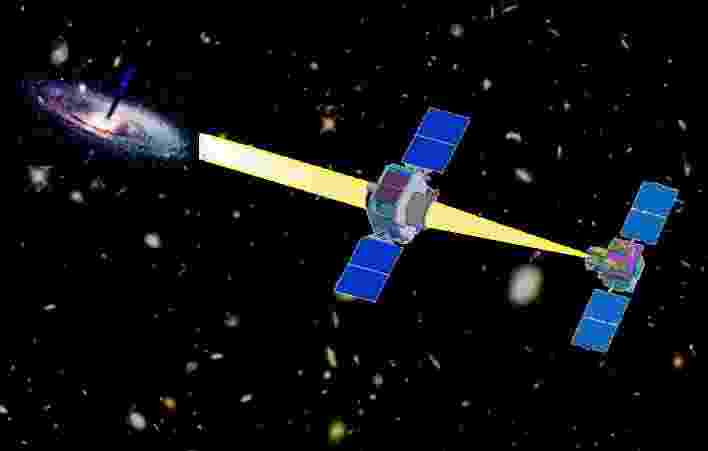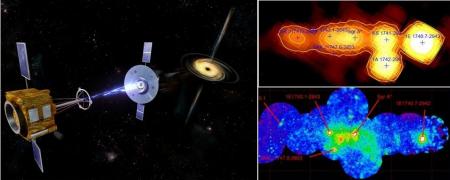 |
Simbol-X |
 |
|---|
A new generation space telescope for high-energy astrophysics
The Simbol-X project is a new generation high energy telescope operating in the 0.5 to 80 keV energy range, using in all this domain the principle of a telescope, i.e. the concentration of the radiation on a small sensitive surface (the eye, a photographic plate, a CCD camera, etc.). Thanks to the advent of space technology enabling satellites to fly in a constrained formation, it is possible to conceive very long telescopes; this is the case of Simbol-X, which will have a focal length of several tens of meters, allowing for the first time to extend the focusing technique to radiation with energy of more than 10 keV.
Simbol-X will study the most high-energy phenomena in the Universe with an image definition and sensitivity more than a hundred times greater than those of current instruments. In particular, this mission will open up a completely new discovery space for the physics of accretion around black holes, the study of particle acceleration in supernova remnants and in jets from the active nuclei of galaxies, and on a larger scale the mapping of clusters of galaxies. Simbol-X will also allow the discovery of deeply buried objects such as those probably responsible for X-ray background radiation, currently hidden from the view of instruments operating at present because they of their lack of the required observation power.

Applying the focusing principle up to energies of several tens of keV requires a long focal length, impossible to achieve with a single satellite. The solution adopted for Simbol-X is to use two satellites, one carrying the mirror and the other the instruments. This telescope will enable the sky to be observed with an unparalleled image quality, as illustrated by the figure on the right, which shows the same region of the sky as it can be seen today (top) and as it will appear with Simbol-X (bottom). (Image credit: CNES/CEA).
To make the most of this new imaging capability, the focal plane uses very compact new generation detectors.
The telescope's focal plane is formed from two superimposed spectral imaging systems, one covering the low energy field (<20 keV) and the other sensitive to photons of 4 to 80 keV, thanks to an innovative system. The high-energy detection plane is made up of a mosaic of Cd(Zn)Te detectors consisting of 16000 individual detectors, which are currently the subject of a research and development program being conducted in close collaboration with the French space agency, the Centre National d'Etudes Spatiales (CNES).
The Simbol-X project, scheduled to be launched in 2014, is a bilateral collaboration between the French (CNES) and Italian (ASI) space agencies, with a participation of German research institutes. On the laboratory side, the Astrophysics Division of CEA/DAPNIA is responsible for France's role in the mission.
Simbol-X has been selected early 2006 for entering phase A, in which preliminary studies were performed and successfully completed in 2008. However, due to budgetary changes of the space agencies, the Simbol-X project has been cancelled in March 2009. Nevertheless, given the great scientific potential of the mission and the interest shown by the community, the project should show-up in the future in another context.




